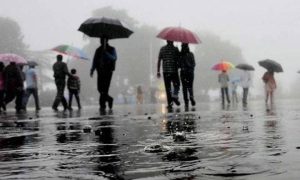While Professor Manindra Agrawal and his team of around eight researchers are awaiting favourable meteorological conditions, they have already started the process of seeking approvals from various agencies for conducting the procedure. Cloud seeding involves the amalgamation of various chemical substances such as silver iodide, dry ice, rock salt and even common salt within clouds, with the goal of enhancing cloud density and augmenting the likelihood of precipitation or rainfall
In a move to combat hazardous air quality, the Indian Institute of Technology-Kanpur (IIT-K) is on the brink of deploying an innovative solution – creating artificial rain by dispersing a blend of salts into the clouds. However, according to the institute’s analysis, the implementation of this rain-inducing procedure is unlikely to occur within this week.
Manindra Agrawal, professor at the computer science and engineering department of IIT Kanpur – who leads the project of inducing artificial rain via cloud seeding – told News18 that as per the present status of the weather forecast, the skies are expected to be clear in the coming week.
While Agrawal and his team of around eight researchers are awaiting favourable meteorological conditions, they have already started the process of seeking approvals from various agencies for conducting the procedure.
“We have begun the process for seeking approvals from multiple authorities including the Directorate General of Civil Aviation (DGCA), Ministry of Home Affairs, and Ministry of Defence among others,” said Agrawal.
Read More: Breaking News: Tremors felt in Delhi-NCR, north India after 5.6 magnitude earthquake hits Nepal
NOXIOUS AIR
Last week, the air quality in Delhi-NCR reached the most critical level on the index, designated as ‘severe plus’, exposing residents to significant health risks.
The extremely concerning Air Quality Index (AQI) in the national capital compelled the central government to take all potential actions to prevent further escalation of pollution levels.
Artificial rain, though offering temporary respite for a week, can provide relief to the residents of the NCR who are desperate for clean air.
Most likely the procedure will take place after Diwali, depending on the availability of clouds and other suitable meteorological conditions.
Read More: Scammers are using voice cloning tech to trick people, can create fake voices of anyone in seconds
WHAT IS CLOUD SEEDING?
Cloud seeding involves the amalgamation of various chemical substances such as silver iodide, dry ice, rock salt, and even common salt within clouds, with the goal of enhancing cloud density and augmenting the likelihood of precipitation.
“The procedure is aptly titled cloud seeding as we are seeding the rainfall,” Agarwal said while explaining the entire process of shooting the chemical mixture into clouds and creating a process of condensation. “Clouds contain moisture, and when foreign particles are introduced, this initiates the condensation process. Once the accumulated water becomes sufficiently weighty, it triggers the onset of rainfall.”
In June, Agrawal’s team, which comprises researchers from different specialisations including bioengineering, management integration, and aerospace engineering, successfully conducted a test for artificial rain via cloud seeding over a limited area on the college campus.
An aircraft ascended from the institute’s airstrip to an altitude of 5,000 feet, releasing a powder spray into dense clouds, resulting in substantial rainfall.
Overall, the cost of leasing a plane equipped with specialised instruments is slightly high. Along with the installation of these tools in the aircraft, it is estimated that for every hour during the operation, around Rs 3 to Rs 5 lakh is spent.
While the project was started five years ago, it got stuck due to the requirement of an imported flare set, which is attached to the wings of an aircraft to shoot the chemical mixture into the clouds.
The product was scheduled to be imported from the United States, but by the time the order was finalised, the global Covid outbreak had spread worldwide.
The project has been effectively executed by Israel, South Africa, and the United States.





































